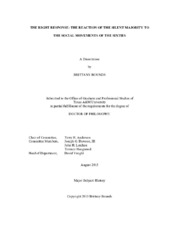| dc.description.abstract | This dissertation examines the conservative response of mainstream Americans to the various social movements that captured the nation’s attention in the 1960s. In conjunction with opinion polls, newspaper articles, and archival collections, this project uses an unconventional methodology by analyzing White House mail summaries and personal letters Americans wrote and telegraphed to the White House in response to liberal activities. I conclude that the group President Richard Nixon labeled the “Silent Majority” – while tolerant of tempered social change – despised protests and demonstrations. These citizens felt they were losing their grip on an American identity established in the 1950s that included American exceptionalism, anticommunism, state’s rights, and a strong sense of morality. To counter demonstrations and perceived media bias, conservatives mobilized and demanded a return to law and order.
My dissertation explores the Silent Majority reaction to the main social movements of the decade, which also examines their interpretation of the American identity. In the first chapter, I ascertain that conservatives and moderates tried to halt the pace of integration by investigating their response to the Freedom Rides, Ole Miss, and the Civil Rights Act. The second chapter explores the conservative response to the New Left and campus protests; they demanded that university administrations regain campus control from radicals and expel protestors. In the third chapter, I examine the Silent Majority’s reaction to antiwar demonstrations and Moratoriums through grassroots organizations and pro-war rallies. The project then turns to the response to the counterculture in the fourth chapter, and how citizens distrusted Hippies and eventually tried to incorporate them back into the mainstream. The fifth chapter delves into the visceral backlash against Black Power and federally enforced busing mandates in the North. The last chapter investigates the grassroots organization of housewives to counter women’s liberation, abortion, and the Equal Rights Amendment. I argue the Silent Majority was not as silent as their moniker implies, and in fact influenced policy decisions and elections, leading to the rise of the neoconservatives in the 1970s. | en |


